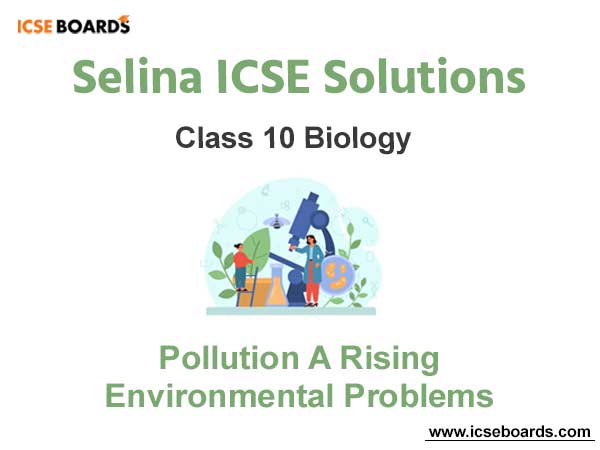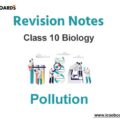A. Multiple choice type
Question A.1. Which one the following is an example of pollutant?
(a) A rat entering your kitchen
(b) CO2 given out by the respiring organisms.
(c) The heat given out while cooking food
(d) The dust raised during road- cleaning
Solution .
The dust raised during road-cleaning
Question A.2. Which one f the following is a “dirty” practice contributing to pollution and seriously needs stoppage by educating the public?
(a) Too loud marriage musical band
(b) disposing of corpses in rivers
(c) Floating lighted earthen lamps (“deeyas”) in rivers
(d) wearing scented/ perfumed clothes
Solution .
Disposing of corpses in rivers
Question A.3. One of the examples of radiation pollutants is
(a) Sulphur dioxide
(b) Ozone
(c) Iodine – 131
(d) Discarded fused electric bulbs
Solution .
Ozone
B. very short answer type
Question B.1. Name the following pollutants:
(i) A pollutant which is mainly responsible for causing acid rain
(ii) Any two chemicals leading to the formation of ozone holes.
(iii) the chemical element which caused minimata disease in Japan.
Solution B.1.
(i) SO2
(ii) Bromochlorodifluoromethane and chlorofluoromethane
(iii) Mercury
Question B.2. Match the items in column I with the closely related ones in column II.
| Column I | Column II |
| Chlorofluocarbons (CFCs)FlyashCow dungCO2 and methaneSulphur dioxideIodine – 131 | (a) Global Warming (b) Biodegradable (c) Nuclear Radiation Pollutant (d) Acid Rain (e) Industrial Waste (f) Ozone depletion |
Solution B.2.
| Column I | Column II |
| Chlorofluocarbons (CFCs)FlyashCow dungCO2 and methaneSulphur dioxideIodine – 131 | (f) Ozone depletion (e) Industrial Waste (b) Biodegradable (a) Global Warming (d) Acid Rain (c) Nuclear Radiation Pollutant |
Question B.3. Fill in the blanks :
(i) Rubber particles and dust raised by running motor vehicles are examples of ________ pollutants.
Solution .
vehicular air
(ii) Too frequent exposure to __________ in a medical diagnostic technique may damage chromosomes.
Solution .
X-ray
(iii) Thermal power plants give out a lot of_____ waste water.
Solution .
hot
(iv) Sewage is a liquid waste from _______.
Solution .
domestic activities
C. Short answer type
Question C.1. List two major harmful effects of each og the following:
(i) Rivers contaminated with sewage.
(ii) Too much gaseous exhausts containing CO2 and SO2.
(iii) Pesticides such as DDT used in agriculture.
(iv) Prolonged noise such as the one produced by crackers throughout night.
Solution C.1.
(i)Rivers contaminated with sewage:
• Pathogens present in polluted water cause a variety of waterborne diseases that harm both humans and animals, as well as the flora and fauna of rivers, seas, and oceans.
(ii)Too much gaseous exhausts containing CO2 and SO2:
• The high concentration of CO2 in the atmosphere has been the main component of the greenhouse effect, which has resulted in recent years in global warming, i.e. an increase in atmospheric temperature. Melting of the polar ice caps contributes to rising sea levels as a result of global warming.
• SO2 is harmful to animals and people, irritating their respiratory systems. Continuous exposure to SO2 has been shown to harm the lungs and raise mortality rates.
• SO2 is also the cause of acid rain.
(iii)Pesticides such as DDT used in agriculture:
• Pesticides kill soil microorganisms, which are essential for recycling nutrients in the soil, and they can enter the food chain, affecting human and animal health. It can harm the lungs and central nervous system, as well as induce reproductive organ failure and immunological, endocrine, and exocrine system dysfunction, as well as cancer risks and birth problems.
(iv)Prolonged noise such as the one produced by crackers throughout night:
• Long-term exposure to high decibel noise destroys the ear drums and can result in permanent hearing loss; • Noise pollution can cause high blood pressure (hypertension), headaches, and a lack of attention.
Question C.2. List the three major constituents of sewage.
Solution C.2.
Three major constituents of sewage:
1. Kitchen wastes
2. Sanitary waste
3. Waste from agricultural lands
Question C.3. What are the common source of oil spills, and how do they affect sea life.
Solution C.3.
• Long-term exposure to high decibel noise destroys the ear drums and can result in permanent hearing loss;
• Noise pollution can cause high blood pressure (hypertension), headaches, and a lack of attention.
Question C.4. Mention any two measures to minimize noise pollution.
Solution C.4.
Measures to minimise noise pollution:
1. Use of loud speakers should be banned.
2. Airports should be located away from the residential area.
D. Structured / Application /skill type
Question D.1. A lot of fish are dying near a sea shore. Describe any two possible causes
Solution D.1.
1. Industrial Waste:
Large number of industries produces waste water which contains various types of chemical pollutants. Such wastes are commonly discharged into the rivers. These chemicals cause irritation to the body systems of fish.
2. Thermal Pollution:
Many industries such as thermal power plants, oil refineries, nuclear plants use water for cooling their machinery. This hot waste water may be 8-10oC warmer than the intake water. This hot water is released into the nearby streams, rivers or the sea and causes warming. The sudden fluctuation in the temperature of water kills the fishes and harms the plant life growing in it.
Question D.2. Look at a cartoonist’s presentation of a kind of pollution given below.
(i) Name the kind of pollution.
(ii) List the sources of pollutions.
(iii) Mention any two harmful effects of this pollution.

Solution D.2.
(i) Noise Pollution
(ii) Industrial machines, workshops, trains, loud conversation, loudspeakers, etc.
(iii) Effects of noise pollution:
1. It lowers efficiency of work.
2. It disturbs sleep and leads to nervous irritability.





